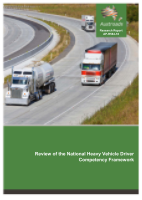Freight

Review of the National Heavy Vehicle Driver Competency Framework
- Publication no: AP-R564-18
- ISBN: 978-1-925671-36-0
- Published: 4 May 2018
- PDF (free) Download
This report reviews the National Heavy Vehicle Driver Competency Framework and its adoption or otherwise by states and territories.
A number of areas for consideration by Austroads are identified including increased focus on or inclusion of additional competencies; minimum training duration and consideration of a practical experience requirement.
The relationship between licensing regulator oversight and VET sector oversight of outsourced provision is considered. Minimum requirements for outsourced trainers and assessors are discussed.
Auditing and review requirements of outsourced service provision are considered.
- Summary
- 1. Background
- 1.1. Factors Contributing to Framework Review
- 1.2. Scope
- 1.3. Methodology
- 2. A National Framework?
- 2.1. Variation in Existing Jurisdictional Arrangements
- 2.1.1. Heavy Vehicle Classes and Licence Progression
- 2.1.2. Requirements and Mechanism for Determining Competency
- 2.2. Value of Experience
- 2.3. A Path to Greater Consistency
- 2.3.1. Practical Test Only or Progressive and Final Assessment
- 2.3.2. Outsourcing versus Insourcing of Licence Assessment
- 2.4. Key Themes and Findings
- 3. Dual Regulation – VET and Licensing
- 3.1. Training Related Entities
- 3.1.1. AISC
- 3.1.2. VET Regulators
- 3.1.3. Industry Training Package Developers
- 3.1.4. Registered Training Organisations
- 3.2. Competency Based Training
- 3.2.1. Understanding Competency
- 3.3. The Framework and Training Providers
- 3.4. Is VET Regulation Sufficient?
- 3.5. Additional Licensing Regulator Controls
- 3.6. Is VET Regulation Required
- 3.6.1. Training
- 3.7. Utilisation of Approved Industry Training
- 3.8. Key Themes and Findings
- 4. Governance of Outsourced Service Provision
- 4.1. Rules
- 4.1.1. Defining Competencies and Assessment Standards
- 4.1.2. Minimum Requirements to be an Approved Provider
- 4.1.3. Minimum Requirements to be an Approved Assessor
- 4.2. Relationships, Systems and Processes
- 4.2.1. Approved Assessors
- 4.2.2. Approved Providers
- 4.3. Regulator Controls
- 4.3.1. Monitoring of Approved Providers
- 4.3.2. Monitoring of Approved Assessors
- 4.4. Management of the Framework
- 4.5. Key Themes and Findings
- 5. Heavy Vehicle Driver Competency
- 5.1. Safety and Competency
- 5.2. Core Driver Competency Elements
- 5.2.1. Competency Under the Framework
- 5.2.2. Comparison of Training and Licensing Units of Competency
- 5.2.3. Safety Factors - Research
- 5.2.4. Vehicle and Related Technology
- 5.2.5. Industry Input
- 5.3. Driver Competency and Job Skills
- 5.3.1. Heavy Vehicle Driving Task
- 5.3.2. Other Available Training
- 5.3.3. Role of Employers
- 5.3.4. Implications for Licensing
- 5.4. Key Themes and Findings
- 6. Adequacy of Current Training and Assessment
- 6.1. Course Duration
- 6.1.1. Adult Learning
- 6.1.2. Nominal Hours
- 6.2. Training Resources
- 6.3. Capabilities of Trainers and Assessors
- 6.3.1. RTO Standard Mandated Qualifications
- 6.3.2. Transport Regulator Requirements
- 6.3.3. Individual RTO requirements
- 6.4. Licence Assessment
- 6.4.1. Gaming the licence assessment system
- 6.4.2. Conditions Under Which Assessment Occurs
- 6.5. Impacts of Outsourcing
- 6.6. Key Themes and Findings
- 7. Austroads Next Steps
- References
- Appendix A National Heavy Vehicle Driver Competency Framework (2011)
- A.1 Introduction
- A.1.1 Scope
- A.1.2 Application
- A.2 Regulation
- A.2.1 Under a National Regulator
- A.2.2 Interim Arrangement
- A.3 Policy
- A.3.1 Under a National Regulator
- A.3.2 Interim Arrangement
- A.4 Administration
- A.4.1 Under a National Regulator
- A.4.2 Interim Arrangement
- A.5 Acronyms
- A.6 Definitions
- Appendix B National Heavy Vehicle Assessment Guide (2012)
- B.1 Background
- B.1.1 Competency Unit
- B.1.2 Aim of the Guide
- B.1.3 The Final Competency Assessment (FCA)
- B.1.4 The Competency Test (CT)
- B.1.5 The Knowledge Test
- B.1.6 Successful Completion
- B.2 The Criteria (15)
- Section A: Pre-drive
- Section B: Vehicle Control and Operation
- Section C: Low Risk Driving Behaviours
- Section D: Compliance
- Section E: Additional Risk Management
- B.3 Assessment Process
- B.4 Content of the FCA/CT
- B.4.1 Off-road criteria
- B.4.2 On-road Criteria
- B.5 Range Statement criteria for the On Road component of the FCA
- B.6 Intersection Hierarchy:
- B.7 Range Statement Criteria for the on Road component of the CT
- B.7.1 Intersection Hierarchy:
- B.7.2 Failure Protocol
- B.8 Assessment Criteria
- B.9 Assessor Guidelines for Determining Competence
- B.10 Access & Equity
- B.11 Non commencement or Termination of test
- B.12 Vehicle and Load Requirements
- B.12.1 Vehicle requirements
- B.12.2 Multi-combination (MC)
- B.12.3 Heavy Combination (HC)
- B.12.4 Heavy Rigid (HR)
- B.12.5 Medium Rigid (MR)
- B.12.6 Light Rigid (LR)
- B.12.7 Use of Buses, Coaches and Motor Homes
- B.13 Assessment in a loaded vehicle
- B.14 Section A: Pre-drive
- B.14.1 Criteria 1 Pre-operational Check
- B.14.2 Criteria 2 Cabin Drill
- B.15 Section B: Vehicle Operation and Control
- B.15.1 Criteria 3 Start, move off, shut down and secure
- B.15.2 Criteria 4 Manages Steering
- B.15.3 Criteria 5 Manages Gears
- B.15.4 Criteria 6 Manages Brakes
- B.15.5 Criteria 7 Manages Accelerator
- B.16 Section C: Low Risk Driving Behaviours
- B.16.1 Criteria 8 Create & Maintain Crash Avoidance Space (CAS)
- B.16.2 Criteria 9 Protect Crash Avoidance Space (CAS)
- B.17 Section D: Compliance
- B.17.1 Criteria 10 Road Rules and Directions
- B.18 Section E: Additional Risk Management
- B.18.1 Criteria 11 Reverse
- B.18.2 Criteria 12 Hill Stop/Start
- B.18.3 Criteria 13 Load Securing
- B.18.4 Criteria 14 Coupling/Uncoupling
- B.18.5 Criteria 15 Bus Stop Procedure
Related publications
WEB-R703-24
FORUM-EOI-DTS-24
WEB-G107-24
Latest Freight News
